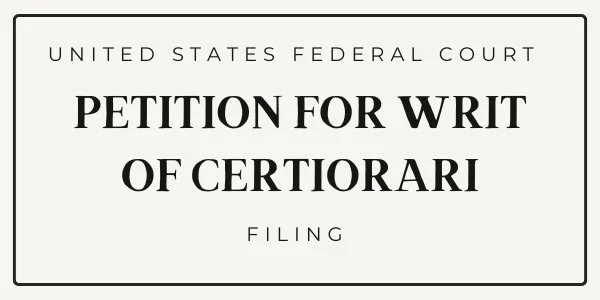Petition for Writ of Certiorari
(United States Supreme Court Filing)
The Petition for Writ of Certiorari asked the United States Supreme Court to review constitutional violations that Alabama courts refused to address. This filing presented the strongest federal questions raised in Murray Lawrence Jr’s case and argued that his conviction could not stand under clearly established Supreme Court precedent.
What the Petition Asked the Supreme Court To Review
The petition presented seven questions, each tied to a direct conflict with federal law:
1. Suppression of exculpatory forensic evidence
The State withheld the Mississippi autopsy and never produced an Alabama autopsy. The Mississippi autopsy established death by ligature strangulation. The prosecution charged gunshot murder in Alabama without forensic support.
2. Racial discrimination in jury selection
The prosecution struck almost every African American juror in violation of Batson. Voir dire pages listed in the petition show repeated strikes with no valid explanation.
3. Coerced and false testimony
Jarius McNeil initially confessed but later implicated Murray after threats of the death penalty. Other witnesses were threatened with charges or loss of children. The petition argued that the State knowingly used coerced testimony in violation of Napue and Giglio.
4. A conviction with no physical evidence
There was no DNA, no prints, no weapon, no blood, and no forensic tie between Murray and the crime scene.
5. Ineffective assistance of counsel
Trial counsel failed to investigate, failed to challenge the false gunshot theory, failed to call alibi witnesses, and failed to object to prosecutorial misconduct. Post conviction counsel then abandoned Murray.
6. Prosecutorial misconduct
The petition documents inflammatory questioning, shifting theories, and a prosecution that implied evidence existed that was never produced.
7. Denial of due process in Rule 32 review
The circuit court issued a one line dismissal of Murray’s Rule 32 petition. The appellate court repeated the same errors. The Alabama Supreme Court denied review without explanation.
What the Petition Highlighted About the Case
The petition made clear that:
• No court had ever held an evidentiary hearing
• The State’s theory was contradicted by its own forensic record
• The indictment charged a crime that the evidence did not support
• Jury selection was racially biased
• The State relied entirely on a single threatened witness
• Murray had an alibi supported by multiple witnesses
• State post conviction review was constitutionally inadequate
These issues created conflicts with established Supreme Court precedent including Brady, Batson, Napue, Giglio, Strickland, Jackson, and Berger.
How the Supreme Court Handled the Filing
The Supreme Court clerk’s office initially returned the petition due to missing in forma pauperis paperwork. The letter on page 19 of the filed document confirms this.
A corrected petition and affidavit were prepared and mailed.
Why This Filing Matters Today
This petition documented all federal questions required for later review. Even though the Supreme Court is not required to hear the case, the filing preserved:
• the Brady violations
• the Batson violations
• the misuse of coerced testimony
• the absence of forensic support
• the ineffective assistance claims
• the due process failures in state review
• the jurisdiction contradictions
This preserves every federal constitutional issue for ongoing proceedings in the United States District Court.
All documents connected to this filing are linked below for public review.
